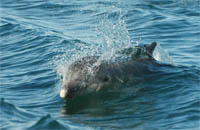Scientific name: Tursiops truncatus
Common local name: tonina

The bottlenose dolphin is the most common and well-known dolphin
species. They are grey, varying from dark grey at the top near the
dorsal fin to very light grey and almost white at the underside.
Adults range in length from 2,5 to 3,5m (with a maximum of 4m) and in
weight from 200 to 400kg with a maximum register of more than 600kg.
Males are slightly longer and considerably heavier than females on
average. Newborn calves vary in length between 85 and 140cm and weight
between 10 and 30kg. The size of the dolphin appears to vary
considerably with habitat.

Bottlenose dolphins typically swim at a speed of 5 - 11km/h; for short
times, they can reach peak speeds of 35km/h.
Normally, they rise to the surface
several times per minute
to breathe
although they can stay underwater for up to 7 - 8min.
Bottlenose dolphins normally live in groups of 2 - 15 animals (although
exceptional groups of more than 1000 animals have been registered
offshore) with sex, reproductive condition and familiar
relationships being the main factors determining group composition.
Basic social units consist out of females with young and mixed groups of
juveniles, stable over the long term. Several of these units can join
together to form larger groups, up to 100 individuals. Adult males live
mostly alone or in groups of 2 - 3 and join the units for short periods
of time.
Female bottlenose dolphins live for about 50 years; the more stressful
life of the males apparently takes its toll, and they rarely live more
than 40 years.
The taxonomy
(study
of the classification of organisms)
of the genus Tursiops was and is still under
discussion. Currently, most researchers agree that there are two
species; Tursiops truncatus (common bottlenose dolphin) with
different regional forms and Tursiops aduncus (Indian Ocean
bottlenose dolphin).
Back